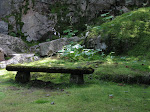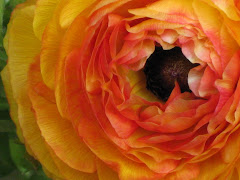Fall is a lovely time to tour gardens. The weather is cool, the leaves are beginning to change and everything seems to be slowing down before winter.
This week, I toured the gardens of the British Embassy in Washington, DC. Originally designed by Sir Edwin Lutyens, the house and grounds are magnificent.
 |
| The gate in the courtyard to enter the gardens (notice the Heuchera 'Bridal Veil' that has been allowed to seed into the wall). |
 |
| The front of the house and the rose garden. The Gingko biloboa (male, of course) trees that flank the front entry were planted after Japanese Maples on decline were removed. Pictures of Teddy Roosevelt on the front steps, with Gingko trees on the sides, guided the horticulturists to plant these new ones. |
 |
| Rather than simple limestone, Lutyens added slate pieces placed on edge, to add visual interest. Set in sand or stone dust, these sections of the large hardscape are permeable and drain well. |
 |
The view from the front entry across the lawn. Before the Magnolias and other trees were so large, the view was of the Washington Monument.
|
 |
| Over time, some of the slate has grown moss, giving it color and variation. |
 |
| The head gardener prunes the Wisteria two times a week. |
 |
| Steps to the perennial borders and upper lawn. Even with nearly 10,000 for EU Day visiting the gardens, the Heuchera 'Purple Palace' survives in the crevices of the limestone steps. |
 |
| Long into October, the perennial border is full of color and interest. |
 |
| The walk to the kitchen garden. |
 |
| The kitchen garden includes espaliered apples and pears with multiple varieties grafted onto the same stock, and Meyer lemons as large as a cantelope. |
 |
| Inside the greenhouse, orchids are abundant. Apparently, there are usually 40 blooming orchids inside the residence most of the time. |
 |
| An orchid in bloom in the greenhouse. |
 |
| Believe it or not, this is a cultivar of Trascendtia (Spiderwort) called 'White Velvet.' |
 |
| I love peaking into other gardeners' potting sheds! |
















No comments:
Post a Comment